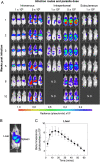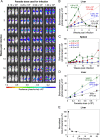Establishment, optimisation and quantitation of a bioluminescent murine infection model of visceral leishmaniasis for systematic vaccine screening
- PMID: 32170135
- PMCID: PMC7070049
- DOI: 10.1038/s41598-020-61662-3
Establishment, optimisation and quantitation of a bioluminescent murine infection model of visceral leishmaniasis for systematic vaccine screening
Erratum in
-
Author Correction: Establishment, optimisation and quantitation of a bioluminescent murine infection model of visceral leishmaniasis for systematic vaccine screening.Sci Rep. 2021 Apr 7;11(1):8015. doi: 10.1038/s41598-021-87190-2. Sci Rep. 2021. PMID: 33828148 Free PMC article. No abstract available.
Abstract
Visceral leishmaniasis is an infectious parasitic disease caused by the protozoan parasites Leishmania donovani and Leishmania infantum. The drugs currently used to treat visceral leishmaniasis suffer from toxicity and the emergence of parasite resistance, and so a better solution would be the development of an effective subunit vaccine; however, no approved vaccine currently exists. The comparative testing of a large number of vaccine candidates requires a quantitative and reproducible experimental murine infection model, but the parameters that influence infection pathology have not been systematically determined. To address this, we have established an infection model using a transgenic luciferase-expressing L. donovani parasite and longitudinally quantified the infections using in vivo bioluminescent imaging within individual mice. We examined the effects of varying the infection route, the site of adjuvant formulation administration, and standardised the parasite preparation and dose. We observed that the increase in parasite load within the liver during the first few weeks of infection was directly proportional to the parasite number in the initial inoculum. Finally, we show that immunity can be induced in pre-exposed animals that have resolved an initial infection. This murine infection model provides a platform for systematic subunit vaccine testing against visceral leishmaniasis.
Conflict of interest statement
The authors declare no competing interests.
Figures





Similar articles
-
Intranasal vaccine from whole Leishmania donovani antigens provides protection and induces specific immune response against visceral leishmaniasis.PLoS Negl Trop Dis. 2021 Aug 17;15(8):e0009627. doi: 10.1371/journal.pntd.0009627. eCollection 2021 Aug. PLoS Negl Trop Dis. 2021. PMID: 34403413 Free PMC article.
-
Identification of Leishmania infantum chagasi proteins in urine of patients with visceral leishmaniasis: a promising antigen discovery approach of vaccine candidates.Parasite Immunol. 2012 Jul;34(7):360-71. doi: 10.1111/j.1365-3024.2012.01365.x. Parasite Immunol. 2012. PMID: 22443237 Free PMC article.
-
Therapeutic immunization with radio-attenuated Leishmania parasites through i.m. route revealed protection against the experimental murine visceral leishmaniasis.Parasitol Res. 2012 Jul;111(1):361-9. doi: 10.1007/s00436-012-2847-4. Epub 2012 Mar 23. Parasitol Res. 2012. PMID: 22437790
-
Efficacy of vaccines based on chimeric or multiepitope antigens for protection against visceral leishmaniasis: A systematic review.PLoS Negl Trop Dis. 2024 Dec 31;18(12):e0012757. doi: 10.1371/journal.pntd.0012757. eCollection 2024 Dec. PLoS Negl Trop Dis. 2024. PMID: 39739955 Free PMC article.
-
Genetically modified live attenuated vaccine: A potential strategy to combat visceral leishmaniasis.Parasite Immunol. 2020 Sep;42(9):e12732. doi: 10.1111/pim.12732. Epub 2020 May 28. Parasite Immunol. 2020. PMID: 32418227 Review.
Cited by
-
The Leishmania donovani Ortholog of the Glycosylphosphatidylinositol Anchor Biosynthesis Cofactor PBN1 Is Essential for Host Infection.mBio. 2022 Jun 28;13(3):e0043322. doi: 10.1128/mbio.00433-22. Epub 2022 Apr 14. mBio. 2022. PMID: 35420475 Free PMC article.
-
Systematic identification of genes encoding cell surface and secreted proteins that are essential for in vitro growth and infection in Leishmania donovani.PLoS Pathog. 2022 Feb 24;18(2):e1010364. doi: 10.1371/journal.ppat.1010364. eCollection 2022 Feb. PLoS Pathog. 2022. PMID: 35202447 Free PMC article.
-
In Vivo Bioluminescence Imaging Reveals Differences in Leishmania infantum Parasite Killing Kinetics by Antileishmanial Reference Drugs.ACS Infect Dis. 2024 Jun 14;10(6):2101-2107. doi: 10.1021/acsinfecdis.4c00109. Epub 2024 May 11. ACS Infect Dis. 2024. PMID: 38733389 Free PMC article.
-
In Vitro Antileishmanial Activity of Achillea santolina Essential Oil against Leishmania infantum Promastigote by Methylthiazole Tetrazolium (MTT) and Trypan Blue Colorimetric Methods.Arch Razi Inst. 2021 Sep 1;76(3):529-536. doi: 10.22092/ari.2020.352245.1555. eCollection 2021 Summer. Arch Razi Inst. 2021. PMID: 34824746 Free PMC article.
-
Central Asian Rodents as Model Animals for Leishmania major and Leishmania donovani Research.Microorganisms. 2020 Sep 20;8(9):1440. doi: 10.3390/microorganisms8091440. Microorganisms. 2020. PMID: 32962237 Free PMC article.
References
-
- WHO. Leishmaniasis. https://wwwwhoint/news-room/fact-sheets/detail/leishmaniasis. (2019).
Publication types
MeSH terms
Substances
Grants and funding
LinkOut - more resources
Full Text Sources

